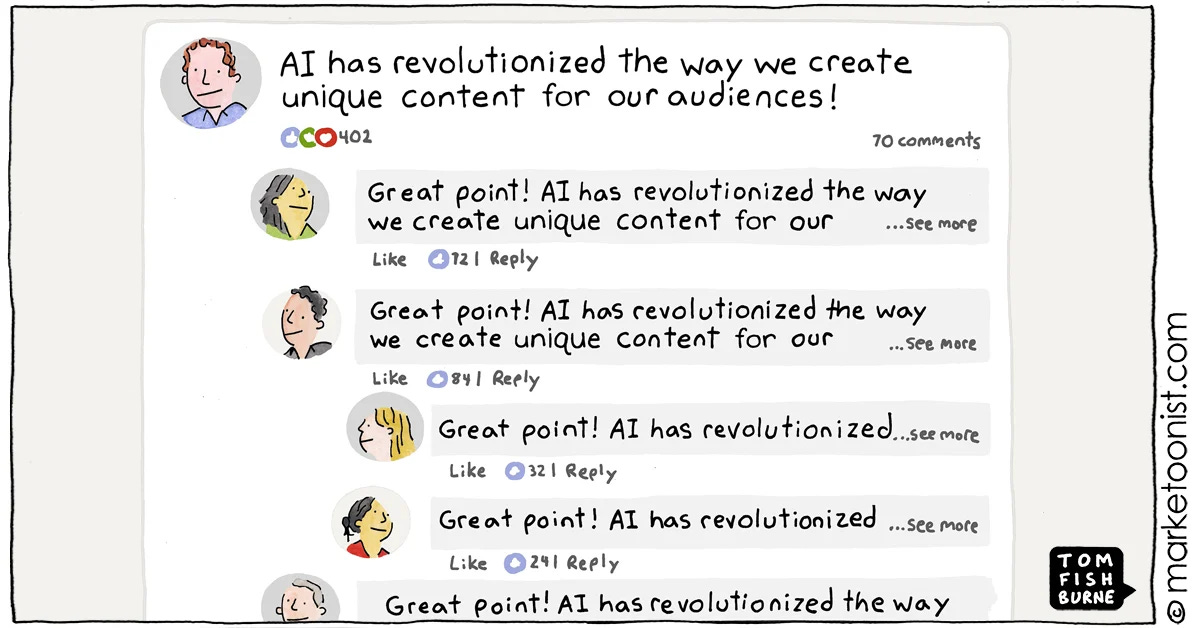The most valuable content is not on the internet
Why your biggest marketing asset is hidden in your meeting transcripts, memories from past conversations, et al.
Welcome to today’s edition of ROBOTS ATE MY HOMEWORK. Today we’re going on a content treasure hunt, but the map isn't on the internet.
A year ago, I watched this documentary about deep-sea explorers searching for a Spanish galleon.
They spent millions on sonar, satellite imaging, and historical chart analysis. They were looking for the wreck by studying everything around it. Then they found a waterlogged page from the captain's log, recovered by a previous expedition. It didn't give a precise location. It described the currents on the day the ship went down. They stopped looking for the wreck and started modeling the water.
They found it in a week.
This is exactly how most of us are trying to do marketing right now.
We’re using the sonar of SEO tools and the satellite maps of competitor analysis, scraping the same public internet as everyone else. We're all looking at the same charts. But the captain's log is sitting right there in our customer conversations.
(8-minute read)
Here’s what’s in it for you today:
Why relying on public data for your AI content strategy is a race to the bottom.
A step-by-step playbook for turning your call transcripts or customer convos into a powerful, defensible content engine.
How to wield a psychological glitch to make your brand the obvious choice in a crowded market.
A prompt for turning customer complaints into your best content, and a link to the book that will change how you listen.
🤖 ROBOT REPORT CARD
An AI model trained on the public internet can only ever be a mirror to that internet. Expecting it to generate a truly novel strategy from commoditized data is a fundamental misunderstanding of the tool.
It’s like a muggle trying to find Platform 9 3/4: they can run at the barrier between platforms 9 and 10 all day long, but they’ll only get a concussion for their trouble.
When I see people feeding generic keywords and competitor URLs into AI, I see muggles running into the wall. They get back a faint, distorted echo of what’s already out there. Competent, but hollow. It has no soul.
Hassan Lâasri notes that because most AI models are trained on the same popular internet data, their outputs inevitably converge. Marketing teams end up using the same punchy lines like “Unlock your potential today!” and support chatbots repeat the same empty apologies, making distinct brands feel identical.
In fact, this problem predates AI. Mark Schaefer coined the term "Content Shock" in 2014 to describe the intersection of exploding content volume and our limited human attention.
But what can you do?
Instead of running harder at the wall, turn away from the public “echo chamber” and tap into your private source of truth: what your customers say when they don’t think they’re being “marketed to.”
This is the playbook for turning those private conversations into a defensible content strategy. It's the exact system we also use at Yahini, our own AI startup, to ensure our work is rooted in truth, not trends.
We call it the "Customer-as-Oracle" Workflow.
Step 1: Capture & Transcribe
Your first job is to become the librarian of your company's wisdom.
This isn't optional.
Record every single sales call, customer interview, and onboarding session.
Every.
Single.
One.
The friction for this is now zero. Tools like Fathom (which is fantastic for this) or Otter.ai can join your calls, record, transcribe, and even summarize them automatically.
This is, at this point, the biggest leverage you’ve got. You are collecting raw, invaluable ore that your competitors cannot access.
Step 2: The Extraction Prompt
Once you have a transcript, the goal is to extract the signal from the noise.
You are looking for specific, emotionally-charged fragments of truth.
What we don’t want is "Customer is having trouble with team collaboration." What we want is:
"We don't need another tool to track tasks. We have a dozen of those. We need to stop the feeling of gut-wrenching dread every Monday morning when we realize a critical handoff was dropped over the weekend and nobody noticed."
Feed your entire, unedited transcript into a large context window AI like Gemini. Use this precise prompt. Do not water it down.
The Extraction Prompt:
You are a world-class marketing strategist and psychologist with a deep understanding of customer motivations. Your task is to analyze the following customer interview transcript with the CEO of [Your Company Name].
Read the entire transcript carefully. Then, extract the following, and only the following:
"Golden Nugget" quotes: Identify 3-5 direct, verbatim quotes from the customer that reveal a deep emotional pain point, a moment of frustration, or a powerful desire. These are quotes that feel significant.The customer's vocabulary: List the exact words and phrases the customer used to describe their problem, their goals, and their situation. Do not paraphrase. What is their "Job to be Done" in their own words?Metaphors and analogies: Did the customer use any metaphors, similes, or analogies to explain their struggle? Capture them. These are windows into their mental model.Unspoken assumptions: What did the customer reveal that they believe to be true about their industry, their role, or our product category? What are the underlying beliefs that guide their thinking?Their Critical Questions: List the most insightful questions the customer asked me during the call. These reveal their biggest knowledge gaps and points of friction.
This prompt forces the AI to move beyond summarization and become a qualitative researcher. It’s digging for the phrases that form the bedrock of compelling copy, resonant blog posts, and high-converting landing pages.
Step 3: The Synthesis Prompt
Now you have the raw materials. The next step is to weaponize them. Take the entire output from Step 2 and feed it into a new chat.
The Synthesis Prompt:
You are a senior content strategist. Using the "Golden Nuggets," "Customer Vocabulary," "Metaphors," "Assumptions," and "Questions" I've provided below, perform the following two tasks:
Categorize the Insights: Group the extracted insights into themes that align with the marketing funnel:Top of Funnel (TOFU): Big-picture problems, existential fears, industry-level frustrations.Middle of Funnel (MOFU): Pains related to evaluating solutions, comparing options, and technical hurdles.Bottom of Funnel (BOFU): Friction related to purchase decisions, trust, budget, and implementation.
Generate Content Angles: For each funnel category (TOFU, MOFU, BOFU), generate 3 specific and non-obvious content ideas that directly address the insights from that category. Frame them as blog post titles, social media thread hooks, or email subject lines. They must be rooted in the customer's actual language.
This is the process that builds a content strategy that cannot be replicated. Because no competitor has your transcripts. They can scrape your blog, but they can't scrape your customers' souls (yet😈).
You stop guessing what your audience wants to read and start using their own words to tell them you understand their problem better than anyone else.
That is an unfair advantage. It’s proof that the best strategy doesn’t come from a bigger AI, but from better data.
💡 A NEW CONCEPT FOR YOU
Let’s talk about a glitch in the human brain called Fredkin's Paradox.
The more similar two options are, the more mental energy we waste trying to choose between them, even though the consequence of the decision is less significant. It’s why you can spend 20 minutes agonizing over two nearly identical shades of white paint for your bedroom walls.
Here's the problem: with AI, the entire market is being pushed into a state of Fredkin's Paradox.
When your competitors are all training their AI on the same public internet, their messaging, their features, and their content all converge toward a bland, indistinguishable mean. They create a sea of near-identical options, forcing your potential customers into a state of decision paralysis.
The "Customer-as-Oracle" workflow above is one way to escape that.
You don't break the paradox by making your font 1% bolder or your features 1% faster. You break it by fundamentally changing the decision-making calculus. The "Golden Nuggets" and "Customer Vocabulary" you extract are the raw materials for a philosophy, a point of view, and a unique way of solving a problem that no one else can replicate.
It allows you to stop saying "we're also a good choice" and start saying "we are the only choice for people who believe this."
✨ ONE MORE THING...
Try this prompt with your next detailed customer support thread:
"Analyze this customer support ticket thread. Identify the root cause of the user's frustration, not just the surface-level question. Now, write a 500-word blog post outline titled 'The Silent Mistake Most [User Role] Make With [Your Product Category]' that addresses this root cause without ever mentioning our product by name."
To get this high-quality data in the first place, you have to ask better questions. The bible for this is Rob Fitzpatrick's "The Mom Test." Read it. It will teach you how to stop asking questions that get you compliments and start asking questions that get you the truth.
This is the real work. Stop asking the internet for answers and start listening to the people who are already trying to give you their money.
So, one final question for you.
If you had to build your entire marketing strategy for the next quarter using ONLY ONE of these data sources, which would you choose?
Your Google Analytics account.
The transcripts of your last 10 sales calls.
Hit reply and just tell me "1" or "2." No long explanation needed (unless you want to). I'm curious where you stand after this.
Until next time,
Chief 🤖 at ROBOTS ATE MY HOMEWORK







2
Excellent advice, prompts and tool tips Mia. Tuned in.